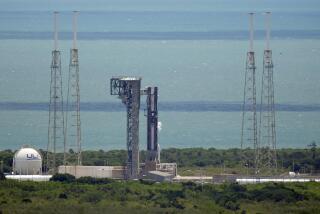Shuttle Crew Solves Clog, but Weather Woes Loom : Space: A cold front at the landing field may mean flight still has to come back a day early. Vehicle’s full waste capacity is restored.
- Share via
HUNTSVILLE, Ala. — Acting in a manner that can only be described as above and beyond the call of duty, crewmen emptied the space shuttle Columbia’s waste water system into plastic bags Sunday, thus gaining a chance to complete their full mission.
But a cold front approaching the landing field at Edwards Air Force Base in California could force the shuttle to land tonight anyway, robbing scientists of another important day of observations with the four telescopes in the Columbia’s Astro observatory.
Flight controllers in Houston said they could wait until early this morning to decide when to land the Columbia.
“It’s now in the hands of the weatherman,” Flight Director Al Pennington said.
Conditions aboard the shuttle had been rather inconvenient, to say the least, for the seven crewmen who had been forced to use primitive measures when the drain tube from the waste disposal system jammed. The threat of losing a day in orbit made it worthwhile for the Columbia’s pilot, Guy S. Gardner, and other members of the crew to pump the waste water into plastic bags, thus restoring the vehicle’s full waste capacity.
“It was kind of fun and exciting--for a little bit,” Gardner told Mission Control’s James Voss.
“OK, we’ll be able to get you a good job as a plumber when you get back,” Voss replied.
Referring to his wife, Gardner quipped: “Well, Linda’s been trying to get me to be at that job for some time now.”
Gardner was not the only one aboard the Columbia having fun. The crew includes four astronomers, who had to direct the telescopes manually when the computer system that was supposed to guide them was lost early in the mission.
The astronomers took over, manipulating the telescopes with a “joy stick.”
One of the Columbia’s astronauts is Robert Parker, 53, an astronomer long before he joined the National Aeronautics and Space Administration, and he drew from past experience as he focused the telescopes on some of the most exotic objects in the universe.
“I told Bob I’m glad to see an old-fashioned astronomer at work,” said Arthur Code, principal scientist on the University of Wisconsin’s Astro telescope, which is aboard the Columbia.
That is the only thing about the mission that reminded Code, 67, of the colorful days when astronomers labored alone in cold, dark observatories.
“When I was a young astronomer, we went up to the mountaintop and sat in a dome all by ourselves,” he said, standing in a control room at the Marshall Space Flight Center here that was jammed with people.
As he gestured at the pandemonium around him, he said softly, “It was so quiet.”
Yet Code, considered to be the grand old man of the Astro mission, would be the last to reject the changes in astronomy. He is the prime force behind the University of Wisconsin’s instrument. It measures the strength of polarized light from distant objects, and that measurement will help Astro scientists learn much about the dynamics of stars and galaxies.
This is the first time that those observations, which cannot be done from the ground, have been done from space.
Parker’s fellow astronomers aboard Columbia are Jeffrey A. Hoffman, 45, of NASA, and civilians Samuel T. Durrance, 46, and Ronald A. Parise, 38. Crewman John M. (Mike) Lounge, 43, is a mission specialist. The skipper is Vance D. Brand, 59, the oldest person to fly in space.
More to Read
Sign up for Essential California
The most important California stories and recommendations in your inbox every morning.
You may occasionally receive promotional content from the Los Angeles Times.













